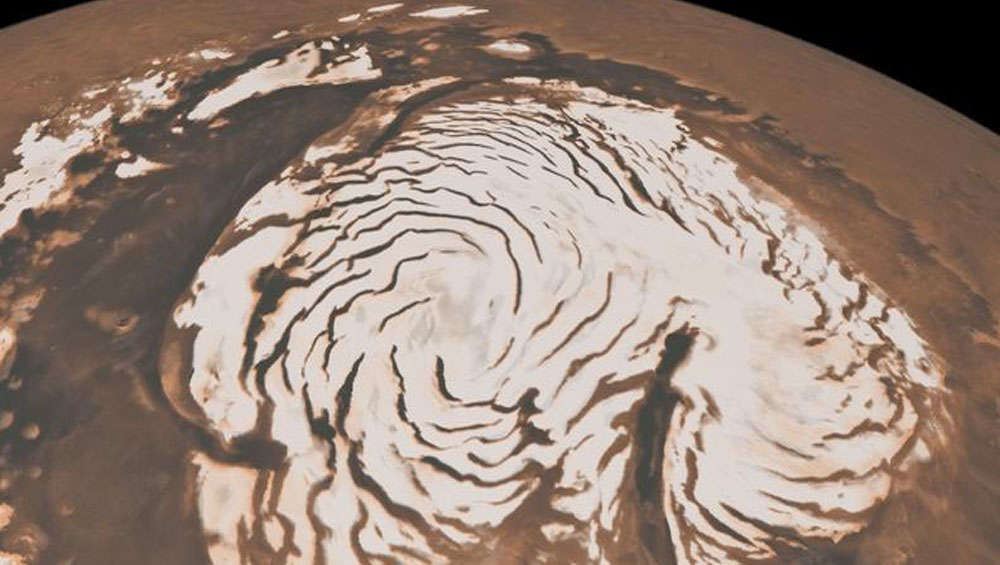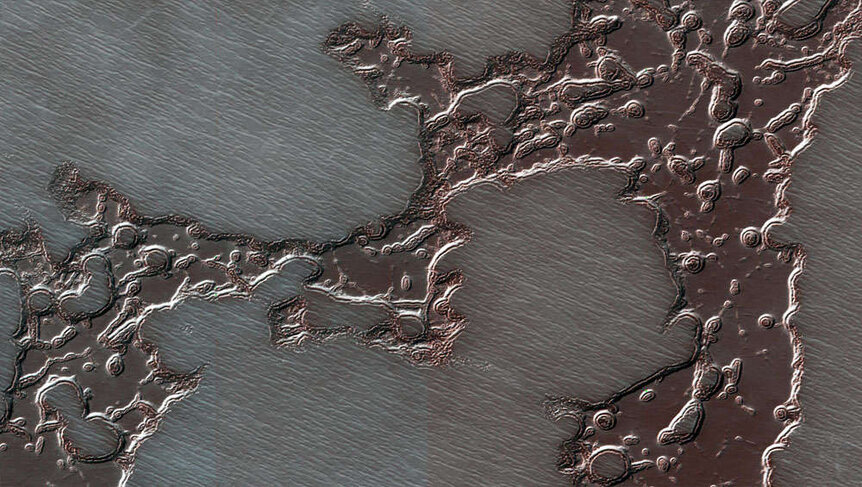Create a free profile to get unlimited access to exclusive videos, sweepstakes, and more!
Monster glaciers on Mars are frozen time capsules from its mysterious past

How did Mars get its glaciers? How have they held up for over 300 million years? What could be trapped inside? So many questions.
The more we find out about Mars, the more mysterious it seems to get. Scientists are now finding out the answers to those long-standing questions about the Red Planet’s glaciers. New and groundbreaking research has revealed the glaciers are covered in rocks that have acted as a giant cooler for the ice underneath. Layers of rock trapped inside different levels of a glacier indicate distinct ice flows. Since these rocks traveled on or inside the ice, erosion was out of the question. As to what is inside, it could be anything — maybe even frozen microbes.
Ice ages start in space. When the orbit of Mars tilts, a phenomenon otherwise known as obliquity, a significant enough tilt can make the poles face the sun, melting polar ice and sending it southward to cold traps. That water needs to escape the cold traps for glaciers to rise.
“On Mars, glaciers form when Mars’ obliquity steps down from high values to moderate values,” planetary geologist Joe Levy, who recently published a study in Proceedings of the National Academies of Science, told SYFY WIRE. “This allows ice to move from cold traps on the Tharsis volcanoes to all of the mesas and cliffs and craters scattered around the middle latitudes, which is where we see glacier deposits today.”
This explains why Martian glaciers reveal how its orbit has evolved and continues to get repositioned. The problem is that using such models to find out how glaciers formed any earlier than 10 or 20 million years ago can be problematic. It involves headache-inducing models of the solar system, according to Levy. The solar system didn’t always look the same as it does to us. Things have been flung around since it came into being, so how the planets were rotating hundreds of millions through billions of years ago remains uncertain. Meaning, the further back you virtually time-warp the solar system, the more chaos ensues in these models.
What can be made out is a possible history of the Martian climate or the probability of how its climate and obliquity changed through the eons. Until now, there has just been no way of determining when exactly when certain glaciers formed.
“What we needed was geological evidence of what Mars’ orbit and climate was doing over the past few hundred million years. The glaciers are that evidence,” Levy said. “On Earth, boulders pile up as rockfall when there’s no ice accumulating on the cliffs above the glacier. When ice builds up during the next glaciation, that layer of debris gets pushed down the glacier. This tells us when glacier ice accumulation is switched on and off. If the same holds true for Mars, that means we’re seeing five or six huge obliquity shifts over the lifetime of the glaciers.”
Buildup in the glaciers themselves can now rewind time from 300 to 800 million years ago. It has proven to be evidence for a climate that was constantly changing, with drastic changes in obliquity that had glacier ice melting, oozing elsewhere and then re-freezing. Where the ice would go depended on how the planet tilted. Mars has a glacier belt around the middle because of these tilt shifts. These glaciers are covered in rocky debris, which accounts for the cooler effect that keeps them from sublimating, or going straight from solid to vapor, during the Martian summer. They also have debris frozen inside them at various levels depending on when each of a series of ice ages happened.
At the dawn of every new ice age on Mars, there would be a new accumulation of ice at a glaciers’ peak. When the planet wasn’t tilting that much, no more ice accumulated, so rocky debris would pile up on top of that ice, but more ice would accumulate on top of that debris when the tilt intensified. Every recurrence of this cycle would result in a new layer of debris inside the glacier. Because both the insulating and embedded rocks have traveled either over on inside the ice, they never reoded. This basically means they are time capsules that could be a major help to astronauts who land on Mars and return some of these samples to Earth for further investigation.
Martian glaciers that capture ice can also provide water for future Mars-tronauts. Though the low pressure on Mars causes most surface water to sublimate before it even has the chance to melt, the debris in glaciers holds on to that ice and gives it an opportunity to melt into liquid water that will be invaluable for extended missions. There could even be melted ice under those glaciers.
“The glaciers don’t tell us if or exactly when any of the ice melted near the surface,” Levy said, “But they provide the critical first ingredients for melt: a huge pile of ice and dark rocks that can capture sunshine and warm the ice.”



























